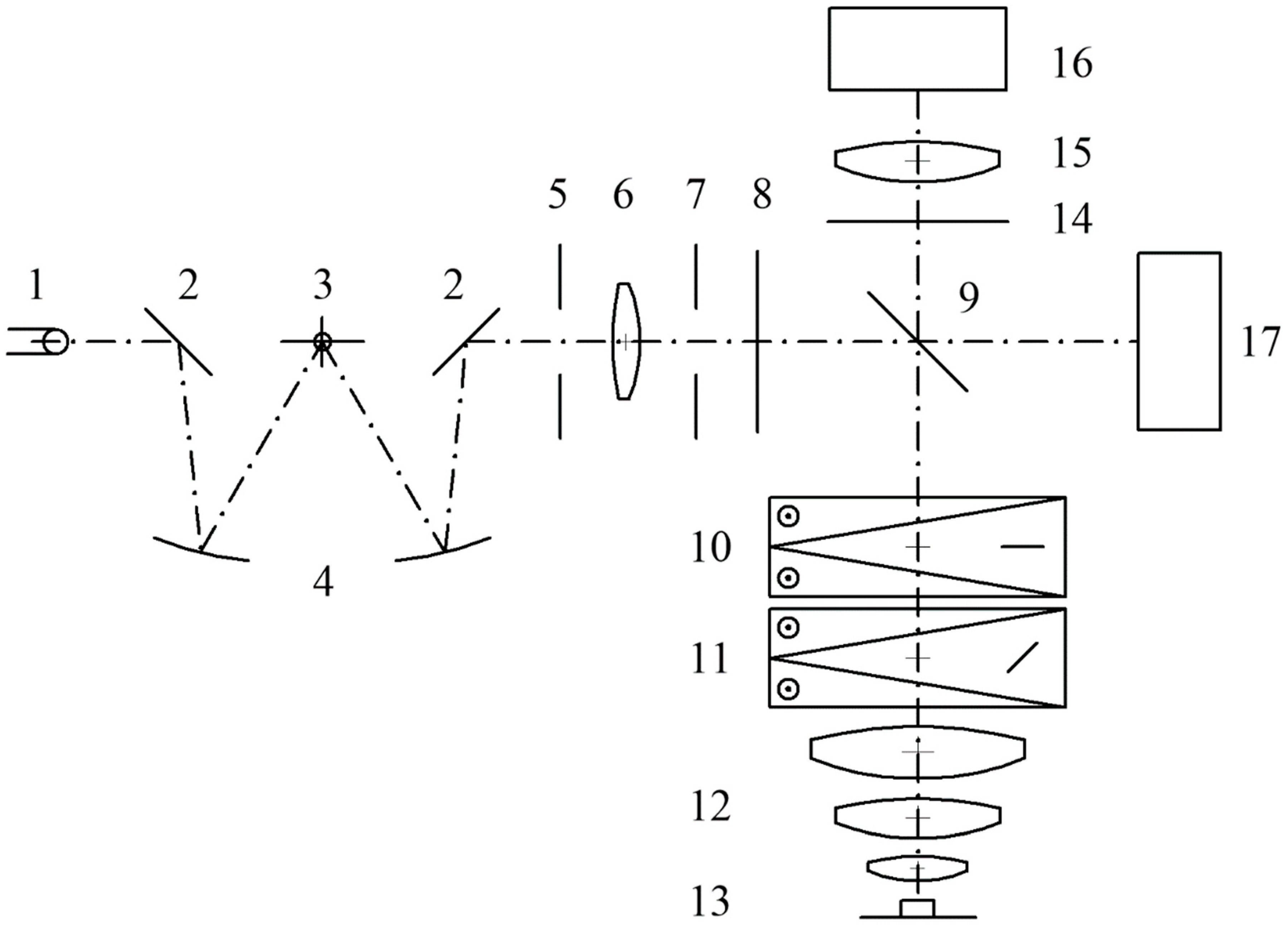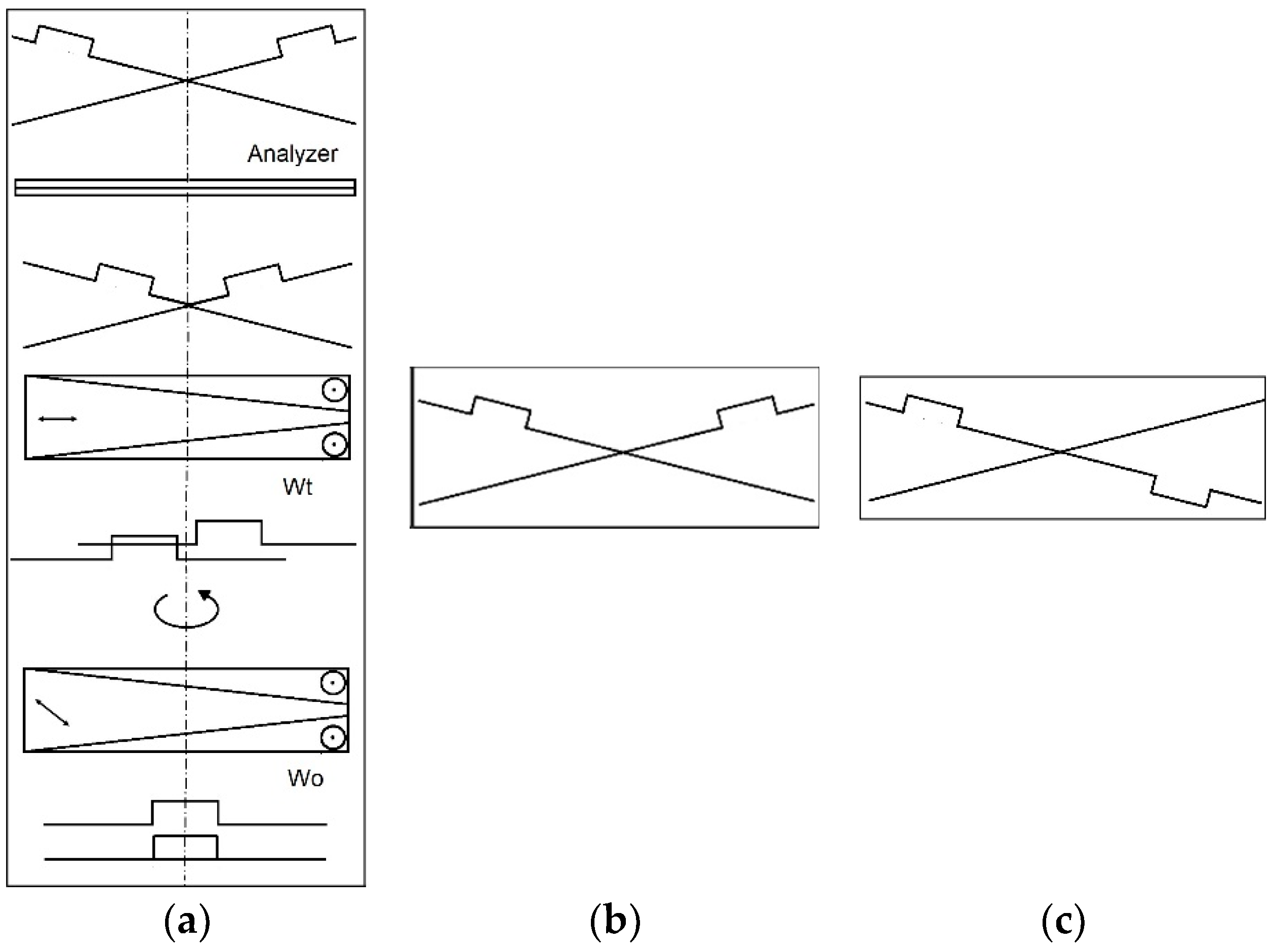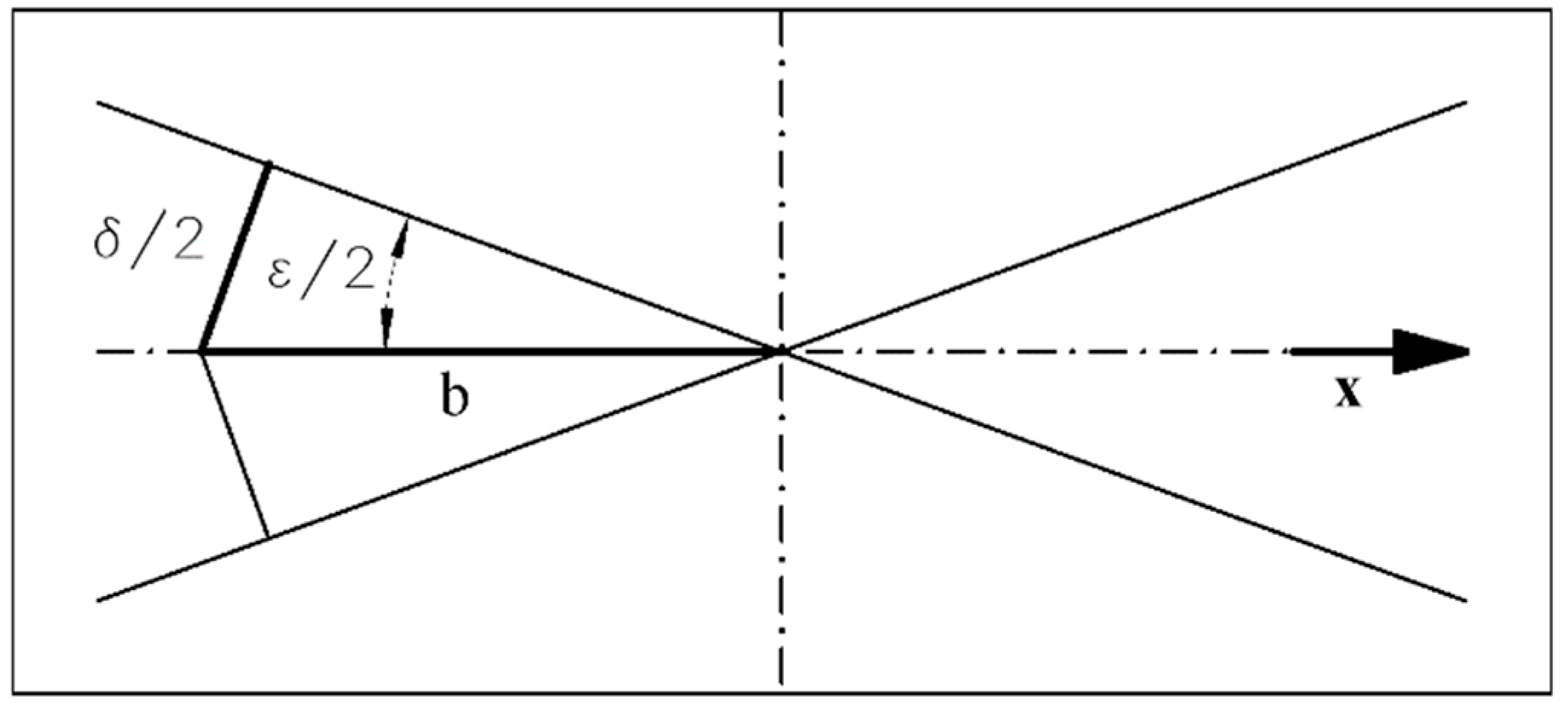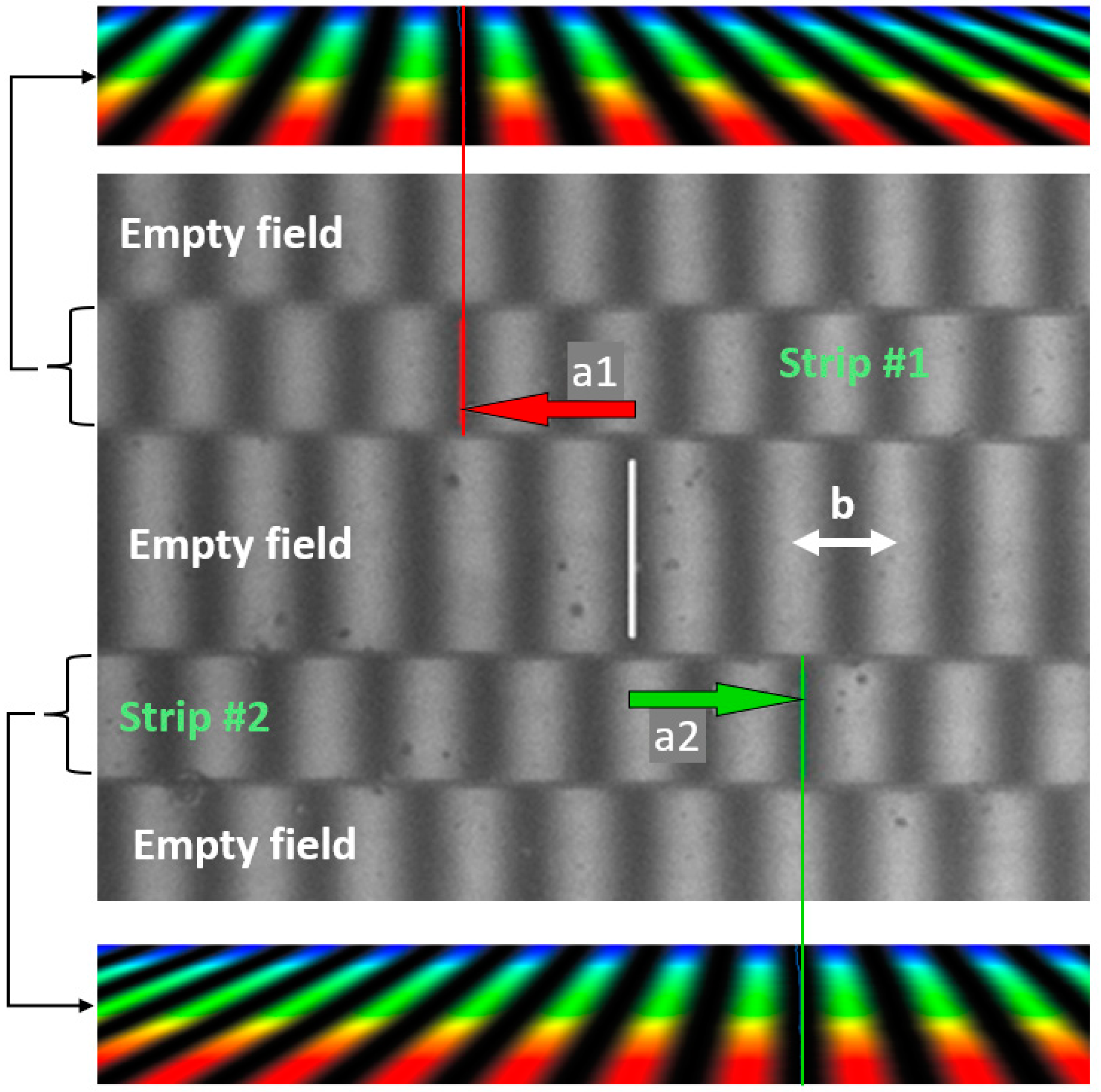A Reflected-Light-Mode Multiwavelength Interferometer for Measurement of Step Height Standards
Abstract
:1. Introduction
2. Materials and Methods
2.1. Optical Architecture
2.2. Theory
2.3. Classical Method
2.4. Equal Thickness Method
2.5. System Calibration
2.6. Software and Simulation
3. Results and Discussion
4. Conclusions
Author Contributions
Funding
Institutional Review Board Statement
Informed Consent Statement
Data Availability Statement
Conflicts of Interest
References
- Pluta, M. Advanced Light Microscopy; Elsevier: Amsterdam, The Netherlands, 1993; Volume 3, pp. 404–506. [Google Scholar]
- Pluta, M. Object-adapted variable-wavelength interferometry. I. Theoretical basis. J. Opt. Soc. Am. 1987, A4, 2107–2115. [Google Scholar] [CrossRef]
- Pluta, M. Variable wavelength microinterferometry of textile fibres. J. Microsc. 1988, 149, 97–115. [Google Scholar] [CrossRef]
- Pluta, M. Variable wavelength microinterferometry of sections, layers, thin films, and like objects. J. Microsc. 1987, 145, 191–206. [Google Scholar]
- Pluta, M. Variable wavelength interferometry of birefringent retarders. Opt. Laser Technol. 1987, 19, 131–140. [Google Scholar] [CrossRef]
- Litwin, D.; Galas, J.; Blocki, N. Automated variable wavelength interferometry in reflected light mode. In Proceedings of the SPIE 6188, Optical Micro- and Nanometrology in Microsystems Technology, Strasbourg, France, 3–7 April 2006; Volume 6188. [Google Scholar] [CrossRef]
- Litwin, D.; Radziak, K.; Galas, J. A fast variable wavelength interferometer. In Proceedings of the SPIE 11581, Photonics Applications in Astronomy, Communications, Industry, and High Energy Physics Experiments, Wilga, Poland, 31 August–2 September 2020; Volume 115810. [Google Scholar] [CrossRef]
- Litwin, D.; Radziak, K.; Galas, J. Alternative approach to variable wavelength interferometry. Photonics Lett. Pol. 2020, 12, 112–114. [Google Scholar] [CrossRef]
- Nagib, N.N.; Khodier, S.A.; Sidki, H.M. Retardation characteristics and birefringence of a multiple-order crystalline quartz plate. Opt. Laser Technol. 2003, 35, 99–103. [Google Scholar] [CrossRef]
- El-Farahaty, K.A.; Sadik, A.M.; Hezma, A.M. Study of Optical and Structure Properties of Polyester (PET) and Copolyester (PETG) Fibers by Interferometry. Int. J. Polym. Mater. 2007, 56, 715–728. [Google Scholar] [CrossRef]
- Falaggis, K.; Towers, D.P.; Towers, C.E. Multiwavelength interferometry: Extended range metrology. Opt. Lett. 2009, 34, 950–952. [Google Scholar] [CrossRef] [PubMed]
- Wengierow, M.; Salbut, L.; Ramotowski, Z.; Szumski, R.; Szykiedans, K. Measurement system based on multi-wavelength, interferometry for long gauge block calibration. Metrol. Meas. Syst. 2013, 20, 479–490. [Google Scholar] [CrossRef]
- Taudt, C.; Baselt, T.; Nelsen, B.; Aßmann, H.; Greiner, A.; Koch, E.; Hartmann, P. Two-dimensional low-coherence interferometry for the characterization of nanometer wafer topographies. In Proceedings of the SPIE 9890, Optical Micro- and Nanometrology VI, Brussels, Belgium, 3–7 April 2016; Volume 9890. [Google Scholar] [CrossRef]
- Miao, F.; Ahn, S.; Moon, H.Y.; Kim, Y. Surface profilometry of silicon wafers using wavelength-tuned phase-shifting interferometry. J. Mech. Sci. Technol. 2019, 33, 5327–5335. [Google Scholar] [CrossRef]
- Koenders, L.; Bergmans, R.; Garnaes, J.; Haycocks, J.; Korolev, N.; Kurosawa, T.; Meli, F.; Park, B.C.; Peng, G.S.; Picotto, G.B.; et al. Comparison on Nanometrology: Nano 2—Step height. Metrologia 2003, 40, 04001. [Google Scholar] [CrossRef]






| Method | 70 nm | 800 nm | ||
|---|---|---|---|---|
| Step 1 nm | Step 20 nm | Step 1 nm | Step 20 nm | |
| ETM | 70.00000 | 69.99987 | 800.00000 | 799.99846 |
| Classical | 70.00000 | 70.00000 | 800.00000 | 800.00000 |
| Equal Thickness Method, ETM | Classical | Session Parameters | ||||
|---|---|---|---|---|---|---|
| Mean | StD | Mean | StD | Phase Noise [deg] | Δλ [nm] | Spectral Range [nm] |
| Step height Standard of nominal value 70 nm (67.53 nm EU measurements) | ||||||
| 69.98915 | 0.04973 | 69.65957 | 1.33802 | 1 | 1 | 530–680 |
| 69.97646 | 0.140834 | 69.75857 | 0.798263 | 1 | 20 | 530–680 |
| 69.92984 | 0.124557 | 67.72356 | 6.580817 | 4 | 1 | 530–680 |
| 69.69206 | 0.25227 | 70.05661 | 10.14141 | 4 | 20 | 530–680 |
| Step height Standard of nominal value 800 nm (778.39 nm EU measurements) | ||||||
| 800.00153 | 0.03596 | 800.74767 | 1.56032 | 1 | 1 | 530–680 |
| 800.04496 | 0.06598 | 799.72384 | 2.47445 | 1 | 20 | 530–680 |
| 799.90762 | 0.18114 | 799.61382 | 7.61079 | 4 | 1 | 530–680 |
| 800.01165 | 0.417622 | 801.86302 | 6.60143 | 4 | 20 | 530–680 |
| Equal Thickness Method, ETM | Classical | Session Parameters | ||||
|---|---|---|---|---|---|---|
| Mean | StD | Mean | StD | Monochro. Step [mm] | Δλ [nm] | Spectral Range [nm] |
| Right-hand crossed Wollaston prisms | ||||||
| 67.26167 | 0.00295 | 69.11500 | 0.08644 | 0.025 | 1 | 530–680 |
| 67.23742 | 0.00269 | 68.81043 | 0.08324 | 0.050 | 2 | 530–680 |
| 67.23068 | 0.00447 | 68.40731 | 0.09644 | 0.100 | 4 | 530–680 |
| 67.21725 | 0.00688 | 68.34139 | 0.09112 | 0.500 | 20 | 530–680 |
| Left-hand crossed Wollaston prisms | ||||||
| 67.10859 | 0.00488 | 65.19099 | 0.12451 | 0.025 | 1 | 530–680 |
| 67.11683 | 0.00277 | 64.66593 | 0.14788 | 0.050 | 2 | 530–680 |
| 67.11909 | 0.00565 | 63.61196 | 0.13870 | 0.100 | 4 | 530–680 |
| 67.12969 | 0.01480 | 58.17638 | 0.17151 | 0.500 | 20 | 530–680 |
| Equal Thickness Method | Classical | Session Parameters | ||||
|---|---|---|---|---|---|---|
| Mean | StD. | Mean | StD. | Monochromator Step [mm] | Δλ [nm] | Spectral Range |
| Right-hand crossed Wollaston prisms | ||||||
| 777.59660 | 0.01368 | 785.90332 | 0.15411 | 0.025 | 1 | 530–680 |
| 777.69886 | 0.00629 | 785.25151 | 0.11773 | 0.050 | 2 | 530–680 |
| 777.68335 | 0.00766 | 785.17949 | 0.15196 | 0.100 | 4 | 530–680 |
| 777.65520 | 0.01036 | 788.12045 | 0.17186 | 0.250 | 10 | 530–680 |
| 777.26195 | 0.01160 | 794.98908 | 0.15371 | 0.500 | 20 | 530–680 |
| Left-hand crossed Wollaston prisms | ||||||
| 777.59585 | 0.00973 | 797.70729 | 0.28867 | 0.025 | 1 | 530–680 |
| 777.56388 | 0.00694 | 799.11664 | 0.10297 | 0.050 | 2 | 530–680 |
| 777.52993 | 0.00890 | 801.80489 | 0.16891 | 0.100 | 4 | 530–680 |
| 777.37119 | 0.00838 | 798.94157 | 0.12076 | 0.250 | 10 | 530–680 |
| 776.96284 | 0.01426 | 784.59328 | 0.18381 | 0.500 | 20 | 530–680 |
Disclaimer/Publisher’s Note: The statements, opinions and data contained in all publications are solely those of the individual author(s) and contributor(s) and not of MDPI and/or the editor(s). MDPI and/or the editor(s) disclaim responsibility for any injury to people or property resulting from any ideas, methods, instructions or products referred to in the content. |
© 2024 by the authors. Licensee MDPI, Basel, Switzerland. This article is an open access article distributed under the terms and conditions of the Creative Commons Attribution (CC BY) license (https://creativecommons.org/licenses/by/4.0/).
Share and Cite
Litwin, D.; Radziak, K.; Czyżewski, A.; Galas, J.; Kryszczyński, T.; Błocki, N.; Szumski, R.; Niedziela, J. A Reflected-Light-Mode Multiwavelength Interferometer for Measurement of Step Height Standards. Sensors 2024, 24, 5082. https://doi.org/10.3390/s24165082
Litwin D, Radziak K, Czyżewski A, Galas J, Kryszczyński T, Błocki N, Szumski R, Niedziela J. A Reflected-Light-Mode Multiwavelength Interferometer for Measurement of Step Height Standards. Sensors. 2024; 24(16):5082. https://doi.org/10.3390/s24165082
Chicago/Turabian StyleLitwin, Dariusz, Kamil Radziak, Adam Czyżewski, Jacek Galas, Tadeusz Kryszczyński, Narcyz Błocki, Robert Szumski, and Justyna Niedziela. 2024. "A Reflected-Light-Mode Multiwavelength Interferometer for Measurement of Step Height Standards" Sensors 24, no. 16: 5082. https://doi.org/10.3390/s24165082






